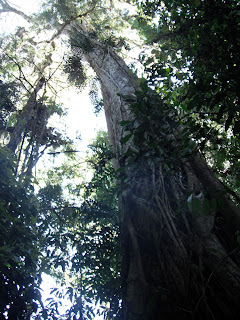After our first rest day, we were right back into the swing of things, and were busy again with lots of schoolwork. We spent Tuesday morning out in the field with our professor Susan, learning how to identify nineteen plant families. Later that day, we had a lecture from our other professor, Erika, on her research. She studies the mating system of Heliconius butterflies, which is unique because the male butterflies compete so fiercely for mates that they sit on the pupae of developing females so that they can mate as soon as (or sometimes even before) the female emerges as an adult. She told us about several interesting experiments that she's done, which are particularly cool because they seem to demonstrate opposite selection on two traits, body length and wing size, that are correlated with each other, so the selection effectively cancels itself out (although this family of butterflies also seems to have evolved a different body size ratio than other closely related families as a result).
On Wednesday, we started the day with another hike out on the Rio Java trail, where we went for our first observations, and then accidentally when trying to find the waterfall on our rest day. We hiked out farther than before this time and dispersed ourselves along the trail to do another observational exercise. Instead of just soaking in the incredible surroundings, this time we were assigned to describe as many plants as we could in our field notebooks. We had about 30 minutes, which feels surprisingly short when you are trying to notice and record as many details as you can about a plant you've never seen (or at least paid such close attention to) before.
 |
| One of the plants I tried to describe had weird bumps on the leaves, which I think were caused by some sort of insect. |
 | |
| A large strangler fig (family Moraceae; above) and some cool vines (below) on the trail. |
By hanging towards the back of the group and taking our time, we also got to see some cool and unexpected wildlife. First we saw a tarantula, which we thought was dead because it wasn't moving at all. After we spent a few minutes poking at it, we realized that it was actually alive after all! Then it decided to pose so we could all take pictures.
 |
| The tarantula was surprisingly cooperative! |
That afternoon we had a lecture on Costa Rican geology, and how topography dictates the climate and weather patterns that allow for such a diversity of ecosystems in the country. Later we watched a short documentary about coffee production in Central and South America, which had economic and anthropological themes in addition to ecological information. Point of story: most of the time, farmers get screwed because of market fluctuations and the time delay before they can alter their crops in response to changing prices, and buying fair trade coffee is really the only way you can assure that the money you're spending is reaching the hands of the people who deserve it. While the concepts weren't necessarily new, it was interesting to get a more detailed look into the processes of coffee cultivation, processing, and sale.
Our last activity of the day was a lecture about forest fragments, to prepare for a field trip on Thursday morning!


No comments:
Post a Comment